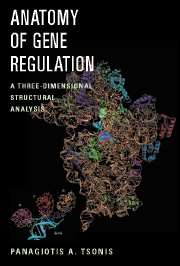Book contents
- Frontmatter
- Contents
- Preface
- 1 A General Introduction to 3-D Structures
- 2 The Higher Organization of the Genome
- 3 Structure of DNA and Telomeres
- 4 DNA Replication
- 5 Transcription in Prokaryotes
- 6 Transcription in Eukaryotes
- 7 Splicing
- 8 Modifications of mRNA
- 9 Compartmentalization of Transcription
- 10 Protein Synthesis
- 11 The Birth and Death of Proteins
- Further Reading and References
- Index
3 - Structure of DNA and Telomeres
Published online by Cambridge University Press: 24 May 2010
- Frontmatter
- Contents
- Preface
- 1 A General Introduction to 3-D Structures
- 2 The Higher Organization of the Genome
- 3 Structure of DNA and Telomeres
- 4 DNA Replication
- 5 Transcription in Prokaryotes
- 6 Transcription in Eukaryotes
- 7 Splicing
- 8 Modifications of mRNA
- 9 Compartmentalization of Transcription
- 10 Protein Synthesis
- 11 The Birth and Death of Proteins
- Further Reading and References
- Index
Summary
PRIMER When we dissect chromatin, we arrive at the highest resolution, which is the DNA wrapped around histones. The structure of DNA, the double helix, needs no elaborate introduction. In this chapter, the basic elements that contribute to the 3-D structure of DNA are presented. The helical DNA can, in fact, assume different structural forms, and we discuss them along with their significance. However, not all DNA exists as double-stranded. At the ends of the chromosomes, DNA is single-stranded and is characterized by a specific nucleotide sequence. The ends of the chromosomes are called telomeres, and they can assume a distinct 3-D structure. This structure is presented along with the structure of proteins that binds telomeric sequence and plays roles in their stability that eventually affect the length of chromosomal DNA and its role in replication and cell division.
THE THREE-DIMENSIONAL STRUCTURE OF DNA
The 3-D structure of DNA is undoubtedly the most recognizable structure of a biological molecule to scientists and nonscientists alike. The determination of the 3-D structure of DNA in 1953 stunned the scientific world and completed the race for understanding how genetic information is passed on to progeny. The DNA is a simple periodic spiral structure made up of two helices. Each helix is made up of sequence of four bases connected via phosphate bonds, and the two strands are held together by a specific interaction between the bases.
- Type
- Chapter
- Information
- Anatomy of Gene RegulationA Three-dimensional Structural Analysis, pp. 14 - 25Publisher: Cambridge University PressPrint publication year: 2003



